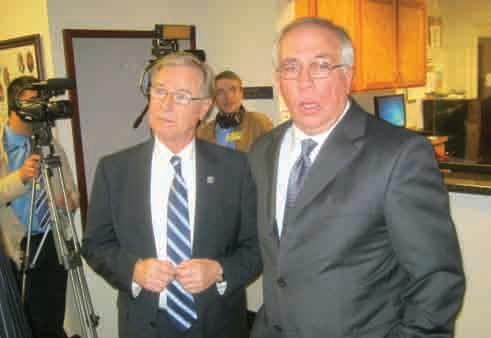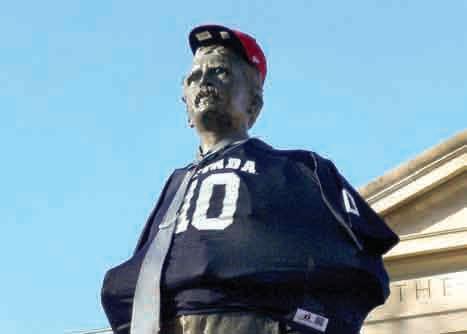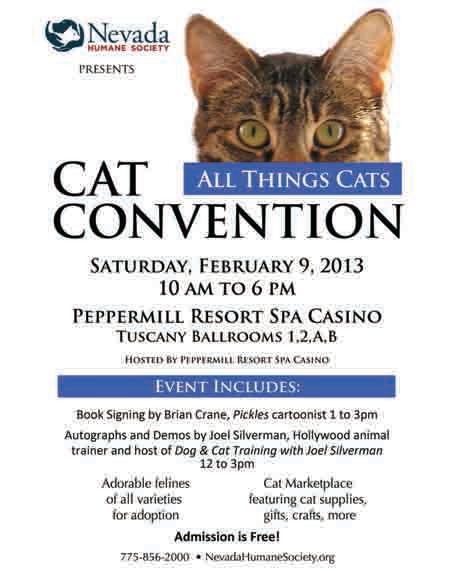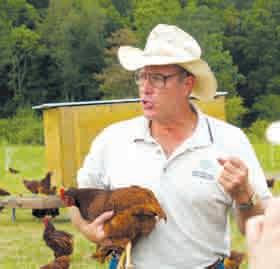
13 minute read
News
from Feb. 7, 2013
Fremont honor proposed
Nevada historian Guy Louis Rocha received a friendly reception when he called for a Nevada place name to honor John Charles Fremont.
Advertisement
Fremont named many geographic locations in Nevada such as Carson Valley and Pyramid Lake, but has not himself been honored that wa, though there are non-geographic features named for him.
Speaking for the Historical Society of Dayton Valley at a Nevada Board on Geographic Names meeting, Rocha suggested that an unnamed mountain in Lyon County be named Fremont Peak. He said Fremont climbed that mountain and, based on his observations, made a decision to turn south, avoiding what are now the Dayton Valley, Eagle Valley (Carson City), and Carson Valley (Gardnerville and Minden).
The NBGN was receptive to the idea, but suggested changing “peak” to “point.” The final decision, if the NBGN approves the idea, will be up to the U.S. Board on Geographic Names.
Fremont became a national hero as a result of his western explorations in the 1830s and ’40s. He was called the Pathfinder by the press. He was also a highly controversial military officer. In 1856 he was the first Republican presidential nominee. Fremont was the subject of the Richard Chamberlain television miniseries Dream West, taken from the David Nevin historical novel of the same name.
NEVADA GEOGRAPHIC NAMES BOARD
Rhee record probed
Former District of Columbia school chancellor Michelle Rhee, who attempted to influence Nevada school policies was the subject of an investigation on the public broadcasting program Frontline. The report examined Rhee’s three-year tenure as D.C. schools chief.
It featured an interview with a D.C. school principal, Adell Cothorne, who said she discovered teachers having a late night erasure session with test papers, an incident she reported to the school district. Nothing was done, she said. In addition, Cothorne said text scores dropped sharply after she installed new security provisions to prevent cheating.
In January 2011, Rhee attended Nevada Gov. Brian Sandoval’s message to the Legislature, and he mentioned her favorably in the speech. Subsequently, her political organization ran a $132,000 broadcast advertising campaign in Nevada to promote two measures that sought to tie teacher pay and jobs to test scores.
At the time, the D.C. inspector general was investigating test scores in the wake of a USA Today investigation that reported abnormal test numbers and erasures on test papers (“Rhee charged with deception,” RN&R, May 19. 2011). Later the IG released a report that found no reason to question the test scores, though critics noted that the IG examined only a single school in the district. Cothorne said she was never interviewed by investigators.
School board intrigues
A revealing tableau unfolded last month at the first meeting of the new Washoe County School Board meeting, in which holdover members tried to prevent the election as board president of one of their own.
There are seven members of the board. Four are holdovers: Barbara Clark, Estela Gutierrez, John Mayer, and Barbara McLaury.
Three are new, and were sworn in for the first time at this meeting: David Aiazzi, Howard Rosenberg and Lisa Ruggerio.
When nominations were opened for board president, there was a surprise— holdover McLaury nominated first termer Aiazzi. The nomination was seconded by holdover Gutierrez.
First termer Howard Rosenberg then nominated holdover Clark and was seconded by first termer Ruggerio. Aiazzi, who said he was taken by surprise at his nomination, said he did “not feel I’m ready” for the job and declined the nomination.
McLaury then nominated holdover Mayer and was seconded again by Gutierrez. Then Clark was elected by Rosenberg, Ruggierio, Aiazzi and Clark.
Taxing job begins
Initiative petition frames the issues awaiting Nevada Legislature
The Nevada Legislature went into session this week, complete with prayers, oathby taking, music, family photos. It was Dennis Myers an awful lot of anti-climactic pomp, given the fact that the 2013 Legislature actually began last month. In 1998, Nevadans voted to reduce the length of legislative sessions to 120 days. In the ensuing years, not one has been that short. Lawmakers, some of whom supported the 120-day limit in the first place, knew it would probably be impossible to accomplish and so promptly began cheating on
Assm. Pat Hickey Assembly GOP leader
that limit in the second place. They began budget hearings in January, though the voter-approved constitutional amendment mandated a February start, a practice followed again this year when budget hearings began on Jan. 23, though the legislative session was supposed to start Feb. 4. Critics of the 120-day limit like Assemblymember Chris Giunchigliani (now a Clark County commissioner), disgusted by the hypocrisy involved, were harshly critical of the early start.
Not only did the legislators start their work early, they usually ended it late. Since the 120-day limit was imposed, special sessions have been needed for the lawmakers to complete their work in 2001, 2003, 2005 and 2007. In 2003, two special sessions were needed.
Another feature of the 1998 change was a requirement that the governor turn over his budget recommendations to the lawmakers in January. Since governors had traditionally delivered their required “condition of the state” reports to the Legislature the first week of the legislative session, that meant that the budget would get to the legislators and the public without the governor’s spin.
So beginning in 1999, governors moved their speeches back to January. And though they could have, as other governors did, sent the report to the lawmakers in written form, or delivered it verbally using new internet video technology, they instead hauled the entire membership of the Legislature up to Carson City in advance of the session for a one-night event, meaning the lawmakers’travel and other expenses had to be paid. In every case, the governors included in the report cautions about how the state needed to watch its money.
Clock has started
But even jumping the gun on legislative business is not likely to make the 2013 session an easy one. The lawmakers face an initiative petition from state teachers that would create a 2 percent margins tax. They must act on it in the first 40 days of the legislative session.
Democratic Sen. David Park (right) and Republican Assemblymember Pat Hickey chat in a hallway at the Nevada Legislature.
Under the system proposed by the initiative petition, a business computes its margins by deducting the lesser of 70 percent of its total revenue or adding the costs of its durable goods purchases plus its pay costs. The 2 percent would be paid on the final computation, after $1 million in total earnings are deducted.
Legislating taxes has always been time consuming, even before the 20day limit. With an initiative petition, the time is compressed even more. By March 15, they must act to either approve the initiative petition, reject it, ignore it, or propose an alternative.
If the Legislature approves the petition, it would go into effect in 2014. The first revenues would be produced in January 1915.
If the Legislature does not approve the petition, either by voting it down or rejectingit , it will go on the ballot for voters to decide its fate. If the Legislature proposes an alternative tax plan, it will go on the ballot alongside the initiative petition.
Forty days is a very short time to produce an alternative. The Legislature has been pressured for more than a decade to overhaul the state’s regressive, unpredictable tax system but the 120-day limit has made that virtually impossible. Areport on the state’s tax system commissioned from Moody Analytics in 2009 as a step toward an overhaul backfired when Moody’s failed to complete the $253,000 study.
The pressure to revamp the state’s tax system is fueled by several factors—the difficulty in predicting revenues that can come from the current system, the instability of the mix of existing taxes, and the current heavy reliance on soaking the poor and middle class for taxes. Lawmakers have always made clear that the first two are their highest priorities.
All three of these concerns are driven by the state’s heavy reliance on sales taxes. Since that reliance was created in 1981, the state has experienced budget crises in 1981-82, 1990-91, 2001, and 2007 to the present time. Nevada is currently the in the worst economic condition of any state. Alarger portion of the incomes of the poor and middle class are subject to sales taxes than those at the top of the economic system.
The reluctance state legislators have to deal with taxes is exacerbated by the fact that the sales tax has reached alltime highs, yet it remains the easiest well to tap. In 2012, White Pine County increased its sales tax. There is an effort now underway in Clark County to raise the sales tax for police purposes. Giunchigliani told a Las Vegas newspaper last week, “I won’t be supporting the sales tax change. Sales tax is regres-



sive. We are already at 8.1 percent.” Washoe is at 7.725 percent.
While Sandoval said last month that “Nevada’s employers cannot afford higher taxes,” Giunchigilani and others say workers cannot afford higher taxes—and that they are more burdened than employers. Las Vegas columnist Patrick Coolican wrote last month that the sales tax contributes to a state economic climate in which “the poorest children have less opportunity to rise into the middle class—once considered an inarguable plank of the social contract—because they often attend mediocre, underfunded schools.”
As one study of Nevada taxation once reported, the rate of collection of the sales tax is so gradual, taxpayers do not realize how heavily they are being taxed. This makes it more politically palatable. There are few political downsides to relying on the sales tax. In addition, the business community prefers it over taxes that would hit companies and corporations, and lawmakers are always more responsive to the business community than to those who are most heavily burdened by sales taxes.
There is some sentiment at this year’s legislature for extending the sales tax to services as well as goods. Aservice tax is generally considered more progressive than the durable goods tax, depending on how it is written. The Nevada Legislature once considered a service tax that applied to auto repairs and barber and beauty shops but not to stock brokerages and legal services, which would have exacerbated the state’s regressiveness problem. Political analyst Fred Lokken said he has seen research that shows Nevada is not collecting a whole array of sales taxes on services that other states have.
“There is a billion dollars worth of fees on banks alone ... that other states collect but Nevada doesn’t,” he said.
The usual Republicans-versusDemocrats dynamic is at play, though Assembly GOPfloor leader Pat Hickey is trying to keep it down at the outset. In a letter to constituents, he wrote, “If Democrats decide, as they say they have, to debate Nevada’s tax structure from ‘day two,’then Republicans should come to the table with both ears and minds wide open. However, if this session is truly to be marked by a new spirit of cooperation, then minority party members in both houses must feel welcome in bringing their recipes for policy solutions to the 77th Session’s bipartisan buffet.”
Gov. Sandoval has a no-new-taxes stance, but while his veto could stop a legislative alternative to the initiative petition, it cannot stop the initiative petition itself. The very existence of the petition forces the legislature to confront the tax problem or be left behind in deciding state tax policy. Ω



reinvent yourself
TAKE ADVANTAGE OF:
- Convenient Class Schedules - Limitless Career Opportunities - Learn from the Experts - Get into the Workforce Sooner
HAIR • SKIN • NAILS
NOW enrolling 855.598.4016
Financial Aid available to those who qualify
Accredited by NACCAS | Programs vary by location Career Placement assistance for graduates For Gainful Employment disclosures, visit www.marinello.com/disclosure
MRLO_11587_RenoNews-Reno_Feb_4.9x5.67.indd 1
RENO 5093 S. McCarran Blvd.
marinello.com
Defining Beauty Education Since 1905
RNR213RNO
2/4/2013 3:20:44 PM
Next year


One day after hometown hero, Colin Kaepernick, went down in Super Bowl flames with his team, the San Francisco 49ers, the oft-abused statue of John Mackay stands absurdly on the University of Nevada, Reno campus. In the days leading up to the loss, disciples left sacrifices that included an empty bottle of Jägermeister, commemorative pins, a ball cap and other litter at the statue’s feet.
Thursday, Feb. 7, 2013 | 7:30 p.m. | Nightingale Concert Hall
Impeccably trained in the classics, these award-winning young string musicians also reveal eclectic tastes for excellence no matter the genre. Their reputation for redefining the rules of chamber mastery has been duly noted: “[SYBARITE5] juxtaposing the likes of Stravinski with Radiohead or Dvorák with Led Zeppelin...doesn’t even begin to describe the range of their eclecticism or the depth of their repertoire.” — Strings Magazine Tickets: Adult $24/ Senior $20/ Student and youth $12
(775) 784-4ART | Buy tickets online at www.unr.edu/pas
Grand Sierra Resort

Summit Pavilion

Seen from space
Canadian astronaut Chris Hadfield tweeted a photograph of Reno from space that has since gone viral.
“I’m fairly certain this is Reno, Nevada,” he wrote on his Twitter page. “The biggest little city in the world.”
The University of Nevada, Reno confirmed that the photograph was of Reno. The image includes much of the region, with Reno brightly lit in the center of the image and dark, rural land surrounding the city.
Out in the wild
Conservation activists are concerned about the pressured resignation of Nevada Department of Wildlife director Ken Mayer and the impact the decision will have on sage grouse protection. Mayer was an advocate for the endangered status of the sage grouse, and many fear his absence will take sage grouse conservation off of the state’s agenda.
Mayer’s resignation comes after several months of an organized effort, headed by former Nevada assemblyman John Carpenter, calling for him to step down, on the grounds that “he was responsible for a decline in deer herds and paying too much attention to sage grouse,” wrote the environmental publication Wildlife News.
But “the true cause of deer decline and sage grouse in Nevada [is] well known,” Wildlife News continues. “It’s the huge range fires that are sweeping the state. They are cased by the cheat grass spread mostly by cattle grazing and hotter, longer summer conditions (climate change).” Several studies on the region have come to the same conclusion.
The U.S. Fish and Wildlife Service has until fall 2015 to make a decision on assigning endangered status to the sage grouse. Mayer’s departure is effective as of Feb. 12. Gov. Brian Sandoval will appoint the successor to Mayer.

Fitting in
Kevin Dick, spokesperson for EnergyFit Nevada, provided a follow up last week for the Reno City Council regarding October’s proclamation of EnergyFit Nevada Day, held on Oct. 22, 23 and 24 in Reno, Sparks and Washoe County. EnergyFit Nevada helps homeowners fund energy assessments, audits and retrofits (“Get fit,” Oct. 25, 2012).
“All 100 special enhanced rebates have been allocated,” Dick said.
Of the 100 statewide, 56 of the rebates were allocated in Northern Nevada, 34 of them in Reno. Since the start of the winter rebate program, 45 Nevada homes have received energy updates and 55 more are in progress, expected to be completed in March.
—Ashley Hennefer
ashleyh@newsreview.com
ECO-EVENT
The Squaw Valley Institute will host farmer and writer Joel Salatin on Feb. 13. Salatin will give a talk, followed by a Q&A session and book signing. Salatin was featured in popular food documentary Food, Inc. and in Michael Pollan’s book, The Omnivore’s Dilemma. 7-9 p.m., Olympic Village Lodge, Olympic Village, Calif. $25 for non-members, $20 for members, $15 for students and seniors. Register at www.squawvalleyinstitute.com.
Got an eco-event? Contact ashleyh@newsreview.com. Visit www.facebook.com/RNRGreen for more.










